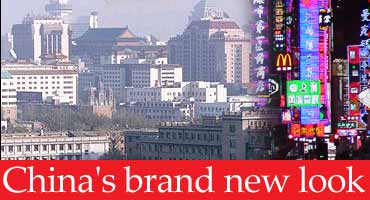Home > Business > Special
Barun Roy |
August 20, 2004

Why is China so desperate to redraw its physical landscape? One answer, of course, is obvious: the 2008 Beijing Olympics.
When the world descends on its capital and takes the opportunity to tour other parts of the country, China wants to be seen as a dynamic, modern country turned towards the future, not a Third World curiosity living in its past.
There's another reason that's not so obvious but is perhaps more meaningful. China has come to believe that the uplift of a nation's spirit depends as much on the creation of economic wealth as on that of a beautiful physical environment. The better the physical conditions, the sunnier will be the people's moods and deeper their sense of pride.
This is a correlation that we in India have never seemed to fully understand. Our cities are seldom pleasant to look at. Our villages are in a permanent state of decay. Even our renovations look patchy and crude.
In its drive for a better image, China wants no patchiness. It appears determined to banish ugliness from its cities and suburbs and wants the makeover to be as complete, modern and cosmopolitan as possible. This may be one reason why it's so open-armed about foreign architects and image-builders.
The experiment began in Pudong, across the river from Shanghai, where foreign architects were given a free hand to transform the former farmland.
Since then it has spread to other parts of the country, but nowhere is it so evident as in Beijing. The Chinese capital is going through what clearly is a total transformation, and visitors in 2008 will, in effect, see a brand new city.
A truly impressive array of new roads, highways, flyovers and ring roads has thoroughly recast the way Beijing looks and moves. In the city's central business district, vast new building spaces are being created.
Old row houses and courtyards are being torn down to create modern urban neighbourhoods. Old streets and alleys are giving in to sleek new roadways. And stunning new landmarks are due to appear on the city's once-monotonous landscape like an abstract painter's brush strokes.
Coming up near Tienanmen Square, behind the Great Hall of the People, is a $ 325 million glass-and-titanium extravaganza -- the Grand National Theatre -- that French architect Paul Andreu has conjured to look like a teardrop floating in an artificial lake.
When the Games open in 2008, visitors will be arriving at a $ 1.9-billion new airport terminal that will forever change their impression of China.
Norman Foster, the famous British architect, who has designed it to reflect the poetry of flight, claims it will be the most advanced airport facility in the world in terms of passenger experience and operational efficiency.
The main stadium at the Olympic Green will be a huge 2,04,100-square metre "bird's nest", designed by Jacques Herzog and Pierre de Meuron of Switzerland, the same architects who designed London's Tate Modern.
Next to it will be the National Swimming Centre, whose stunningly simple and concise design, by Australia's PTW and Ove Arup, makes it look like water bubbles crystallised as a rectangular cube.
In the next four years, 500 new hotels are to be built in Beijing in addition to the 300 it already has, as well as hundreds of new apartment blocks and shopping malls. The combined visual effect of all these new constructions, in which foreign architects will have a big say, is bound to be overwhelming.
China's spending on new construction is growing by 8 to 9 per cent annually, surpassed only by the US and Japan. It's hardly a surprise that more than 120 foreign architectural firms have a presence in the country, as do over 140 of the top 250 of the world's design and construction companies.
This year, in line with China's World Trade Organisation commitments, wholly-owned foreign real estate enterprises would be allowed to function.
In Tianjin, Shanghai, Harbin and Chengdu, as in many other cities and towns, old neighbourhoods are being spruced up and new satellite communities are being built from scratch for the country's expanding middle class. Slowly but inevitably, China's urban and suburban landscape is beginning to look like Europe's and America's.
To the south-east of Beijing, next to the highway to Tianjin, a husband-and-wife team of Chinese architects-turned-promoters is building what is claimed to be one of the most ambitious private sector architectural projects in the world.
Designed by the famous Iraqi-born British architect Zaha Hadid and called Soho City, it will be a million square metre community of apartments, offices, shops and parks where Hadid's fascination for fragmented geometry and fluid mobility will create a totally new way of seeing and experiencing space.
Faced with this new reality, the Chinese are now turning to their artists to preserve their old landmarks on canvas before they finally disappear. Powered by 